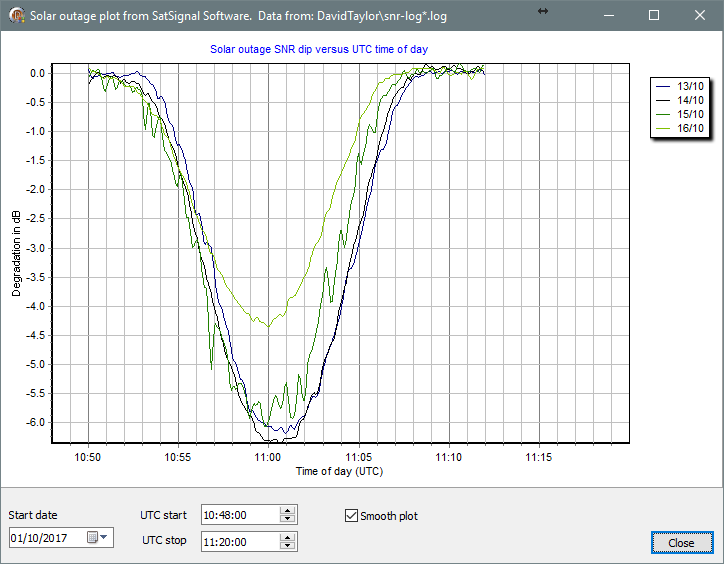Solar outages to be expected on EUMETCast in Spring and Autumn
Technical information from Arne van Belle
Twice a year, in the spring and the autumn the sun passes across the equator directly behind each geostationary satellite in the Clark belt. When the main beam of our EUTELSAT-10A dish is in direct line of sight with the sun, a sun outage occurs. The LNB (low noise block) is bombarded by the sun’s RF radiation focussed by the dish. This causes a drastic deterioration of the receive C/N (carrier to noise ratio). Basically, the satellite signal is overwhelmed by the unwanted signal from the sun; the signal from the sun is what we call noise. This phenomenon is also known as Sun transit or Solar Interference. Solar outages only affect downlinks (receivers), not uplinks (transmitters). They also occur in cloudy weather, as the RF radiated by the sun is only dampened slightly by clouds.
A solar outage will effectively cause about 10 minutes loss of signal from that satellite. On the days before and after when the sun is directly aligned with that satellite there will be less outage. The actual days and times depend on your latitude and longitude, longitudinal position of the satellite, diameter of the dish and the received frequency. The larger the dish diameter and higher the frequency, the shorter time and the fewer days sun outages last.
Can it damage my system?
Modern LNBs can handle the high levels of RF noise (using moderate sized dishes). But during a solar outage all visible sunrays will be focused on your LNB. Normally a LNB can cope with this, but in exceptional cases (a wet, shiny dish surface and bright, sunny weather), the plastic cap covering your LNB can burst!
Can I prevent this?
You cannot block the RF noise from the sun without blocking the signal from EUTELSAT-10A, so everyone will experience loss of signal during a solar outage. But you can block the visible sunrays by putting a non-transparent plastic bag over the LNB or dish without blocking EUTELSAT-10A’s signal. Alternatively you could swing the dish out of position during a sun outage to prevent damage to the LNB.
When will I be affected?
To calculate the date and time of solar outages you need to know your latitude and longitude, the longitudinal position of the satellite, the receive frequency and the diameter of your dish.
David Taylor has extended WXtrack to calculate solar outages (registration required).
Go to View, Solar outage… Check the default values already entered, and
then go to the “Outage List” tab.
For my location in the Netherlands, solar outages in 2003 for the previous
EUMETCast satellite are predicted for October 7 to 15, between 10:41 and 10:55 UTC with a peak outage on October 11.
Practical information on receiving EUMETCast data.
Arne van Belle
Co-ordinator Radio Observers
Werkgroep Kunstmanen
N51.774 E4.612
Software
I have some software which I've used to monitor solar outages here,
in the hope of seeing what errors I may have in my dish alignment. Here's
an early plot:
